Male student retention strategies have never been more important for community colleges.
In part one of our blog, “Avert a Male Student Enrollment Crisis: How to Market to Young Men,” our founder Dr. Pam Cox-Otto talked about the significant enrollment drop in male students.
Now, we’ll discover hands-on techniques and tips to stop the drop from Dr. Diane Walleser, our vice president of client strategy and CEO. From student services tips to communication considerations, you’ll find robust strategies to retain male students and help them persist.
The Key Question for Male Student Retention: Where Are You Losing Male Students?
According to Walleser, it’s crucial to pinpoint students’ pain points, from application to graduation.
“It’s really important to understand where you are losing your students and when,” says Walleser. However, “This is no easy task because the data is all over your organization.”
Different pieces of the onboarding puzzle hide in the recruitment department, admissions, registrar’s office, and institutional effectiveness. That’s why Walleser says many colleges benefit from an onboarding review, which can zero in on exactly where colleges are losing students.
Data is crucial for plugging the leaks in the onboarding process. As Walleser recalls from her time at the Borough of Manhattan Community College, their research showed that male students weren’t taking any further action after they were accepted. Upon close inspection, Walleser discovered the hurdle: Students weren’t scheduling their orientation appointments.
“Once we knew that was the bottleneck, we had student ambassadors call them to make the appointment and help with that next step,” says Walleser. “This is the kind of intervention you need for all those barriers in the student life cycle.”

Make It Easy to Ask for Help: 3 Simple Strategies to Boost Male Student Retention
Male students are often reluctant to ask for help because of gender expectations and stereotypes, according to Walleser.
That’s why she says, “You have to make it really easy for them to ask and get help.”
The following are effective techniques to help men find the support they need to make it from the first day of classes to commencement.
1. One-Stop Centers Boost Accessible Support
One-stop centers are an effective strategy for reducing student runaround and streamlining their educational experience. Conveniently located on campus or even online, these centralized one-stops offer services including enrollment, registration, degree planning, transcripts, financial aid, and payment, all in one place at one time.
The goal is to make the experience as friendly as possible and build student retention. Let’s face it: Administrative processes can be complex and overwhelming. Offering a central location where trained staff can provide student-centered services is more efficient. Plus, it makes support more accessible to diverse learners — including male students from historically marginalized populations.
“So often, a student thinks they have a financial aid question, but it’s really a registrar issue,” says Walleser. “It’s crucial to minimize that back-and-forth with students.
“Male students, in particular, don’t tolerate that level of runaround.”
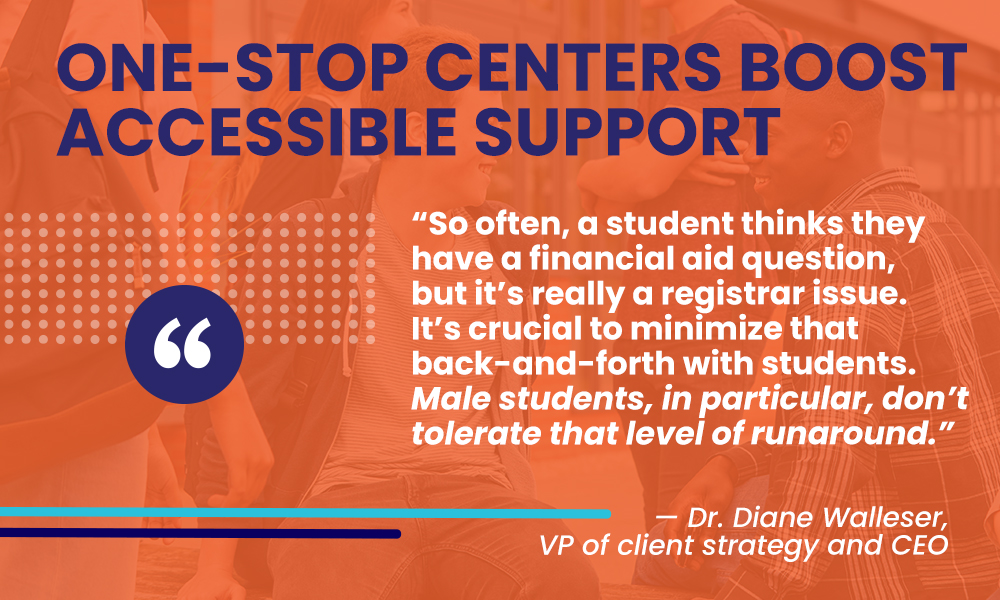
2. Chatbots for Around-the-Clock Retention
“Chatbots are really effective for 24-7 reach,” says Walleser.
She quotes the famous example of Georgia State University, which essentially closed the achievement gap based on race, ethnicity, and income, in part by setting up a chatbot. The first summer the university deployed the chatbot, it delivered more than 200,000 answers to questions posed by incoming first-years, according to GSU’s website. The process reduced summer melt by a staggering 22 percent.
“The chatbot was particularly effective with male students who had just applied,” explains Walleser. “They were very willing to go onto the chatbot to get a question answered, but they weren’t comfortable actually asking someone for help.”
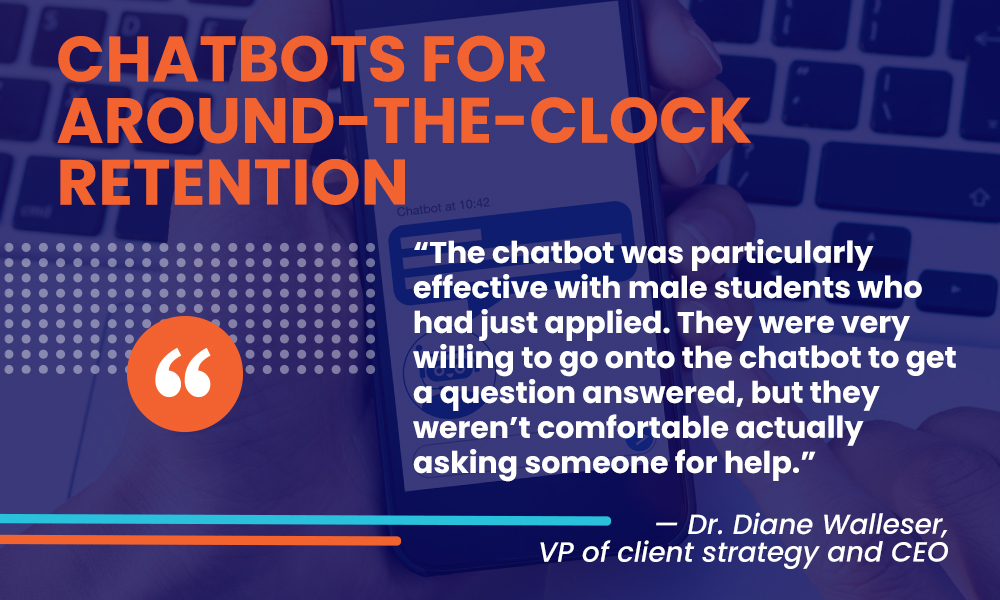
3. Nudges, Early Alerts, and Kudos Bolster Male Student Retention
Breaking down complex processes into simple steps is essential for all students, but especially for men.
“Giving male students a 22-step process is a formula for disaster,” counsels Walleser. “They need one step, one nudge at a time.”
Similarly, early alerts are important. How colleges send messages, reminders, and encouragement can make all the difference in male student retention and persistence. In fact, Walleser says that giving encouragement is an easy way to bolster students’ confidence. A little praise can go a long way in keeping men in college.
“Celebrate their successes, help them get through each semester, and give them kudos along the way,” advises Walleser
3 Communication Considerations
On the road to retaining male students, crafting your messages with care is a key for success.
1. Eliminating Vinegar Words: How to Sweeten Your Messaging to Build Retention
“Words matter, so choose them very carefully,” says Walleser, especially for male students. A cold or punitive message from the business, financial aid, or registrar’s office can discourage students to the point of stopping out.
“‘Unfortunately, regret, rejected, denied, unsatisfactory, revoked’ — all of these words are what we call ‘vinegar words,’” says Walleser. “They are really distasteful to students.”

This kind of language is punitive, focusing on recipients’ failure and the consequences of that failure. To bolster male student retention, eliminate these vinegar words from your written and verbal communications and sweeten up your messaging.
“It’s really important to train your staff on how to communicate with students in a very positive, warm way,” says Walleser. “Switch to ‘honey’ words and create welcoming communications.”
2. Accentuate the Positive
Your tone and phrasing also greatly impact how students respond to messaging.
Consider the difference between “We’re here to guide and support you” versus “We’re here to support and assist you.” It’s a small, subtle shift that completely changes the message and makes the second version more empowering.
“Think about saying ‘When you graduate’ instead of ‘If you graduate,’ and ‘When you pass this class’ instead of ‘If you pass this class,’” says Walleser. “Those simple word changes make a big difference.”
3. Keep It Personal
“Non-personal messages are a real turnoff for males,” says Walleser.

In fact, non-personal, automated advising alerts have a stronger negative effect on men than women, according to the Lumina Foundation’s Community Insights.
So, on top of using welcoming, empowering messaging, try personalizing your communications as much as possible. When automated messages can’t be avoided, ensure they are as warm as possible and written for humans.
2 Ways Male Student Support Programs Build Retention
What can student services do to better support male students? Below are a few best practices:
1. Male Peer Ambassadors
Male student ambassadors can make all the difference in helping their peers persist. Since men often respond better to other men, try to have an equal number of female and male student ambassadors.
As Walleser recalls from the Borough of Manhattan, there was a time when high-risk male students weren’t converting, and many were stopping out during their first semester.
“You only have four to six weeks to make a connection with a new student,” says Walleser. “That connection is critical for them sticking it out and getting to the end.”
To fix the drop, Walleser worked with admissions directors to write scripts based on the hurdles students encountered in their first few weeks of school. Then, they enlisted their second-year, paid student ambassadors and trained them to help first-year students. “We turned those ambassadors loose and had them call and text students,” recalls Walleser. “Every week, they reached out and connected to 50 students.”
Ambassadors followed the script, and each week, they relayed a different message addressing common pain points in that cycle of the student journey. For example, they asked, “Did you find your classes? Do you have your books?” And if the first-year students were stuck, the ambassador would help.
“This program was immensely successful,” recalls Walleser. “The first semester we tried it, two percent fewer students stopped out.”
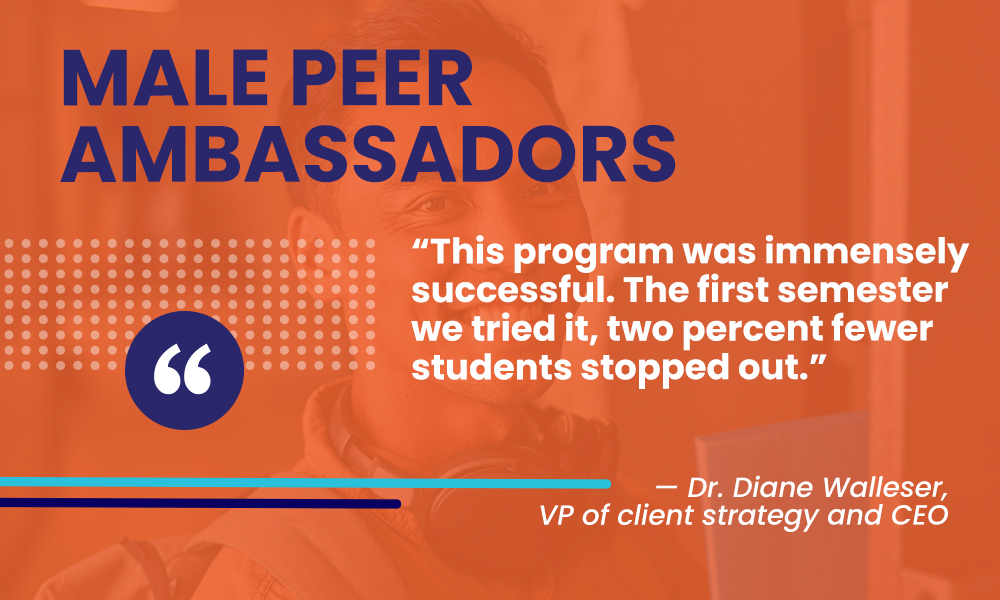
In a body of 20,000+ students, two percent added up to a huge difference.
2. Male Mentors, Advisors, and Affinity Groups
Another successful practice is male mentor programs. As Walleser recalls, one of her former colleagues ran informal “lunch and learn” sessions with male faculty, staff, and Black and Latino students.
According to Walleser, “The group gave students direct access to professors and folks at the college who they could relate to and create a mentoring relationship.”
Male advisors are also key since male students often respond more positively to male advisors.
“A lot of times, our ratios of female to male advisors are not equal,” says Walleser. “It’s really important that we intentionally raise our number of male advisors.”
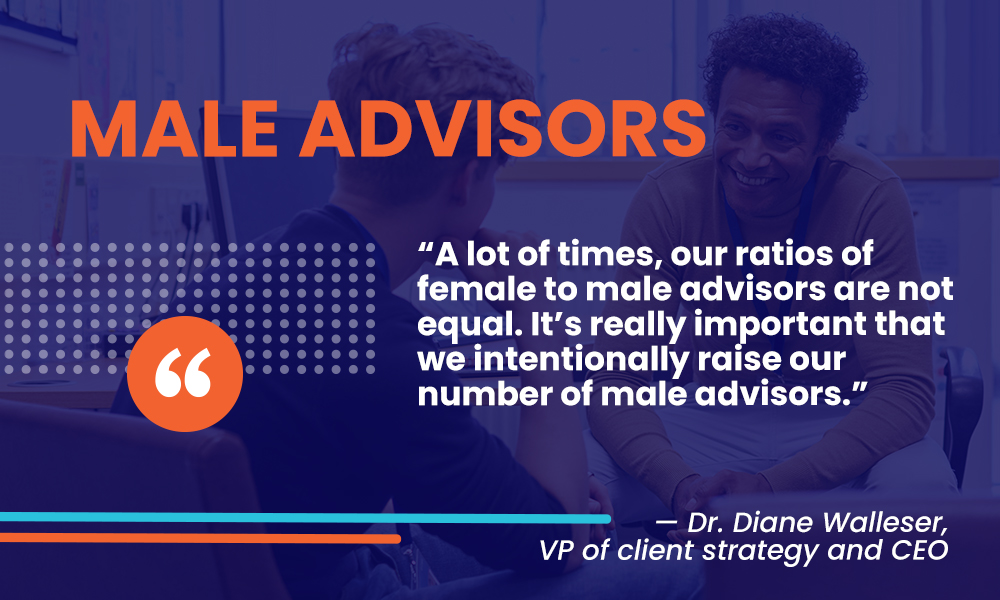
Lastly, connecting male students to affinity groups can give them the sense of belonging and peer support they need. Whether it’s Puente, Umoja, or an LGBTQ+ club, it’s important to make sure incoming students know about these support groups.
2 Ways to Keep Male Students on Track
Below, you’ll find some savvy strategies to recapture stop-out students and to share success stories to inspire the next generation of male learners:
1. How to Regain Male Stop-Out Students
If you do lose male students, how can you get them back? First, find out the reason why they stopped out.
“Most students exit because of financial issues,” explains Walleser. Solutions include programs that will forgive their debt as well as scholarship opportunities.
“At the Borough of Manhattan, we worked hard to offer scholarships with lower GPA requirements because we knew many of our male students have a lot of work and family responsibilities and can’t get those high GPAs,” says Walleser. “Those students needed the help the most, and that extra scholarship money makes a big difference.”
Another simple practice is lifting financial holds so students can still register for classes. When she instituted a program like this at her previous college, Walleser saw impressive results:
“When we delayed their debt, 80 percent of students were able to come back and stay in college while continuing to pay down their balances.”
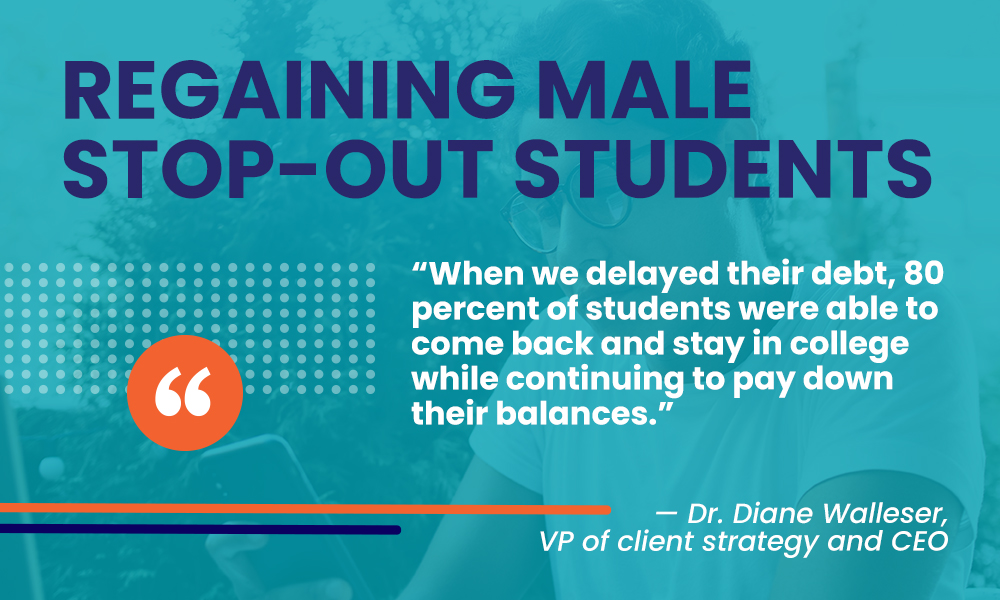
2. Celebrate Success and Inspire the Next Generation of Male Students
Finally, when students achieve their goals, celebrate! And have grateful grads share their triumphs with incoming students.
“Let them tell their stories because they have great stories to tell,” says Walleser. “Let them be an ambassador for your college and inspire other young males seeking a college education.”
Don’t Miss Another Webinar!
These takeaways are from our webinar hosted in partnership with NCMPR, “The Drs. Are In: Where Have All the Men Gone?”
Interact regularly hosts informative, free webinars you won’t want to miss.
Make sure to sign up for our newsletter and keep your finger on the pulse of higher ed enrollment and marketing.
Key Takeaways for Boosting Male Student Retention
Below are Walleser’s strategies to attract male students and help them persist:
- Where Are You Losing Male Students? It’s critical to pinpoint students’ pain points from application to graduation.
- Make It Easy to Ask for Help: One-stop centers, chatbots, plus nudges, early alerts, and kudos are all excellent strategies to help male student retention.
- Eliminating Vinegar Words: Sweeten your messaging, keep a positive tone, and keep communications personal.
- Use male student support programs, including male peer ambassadors, male mentors and advisors, and affinity groups.
- Regaining Male Stop-Out Students: Find why you are losing these students. If you are losing male students for financial reasons, help them with scholarships, debt forgiveness, and lifting financial holds so they can still register for classes.




